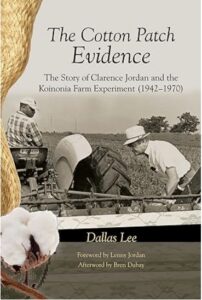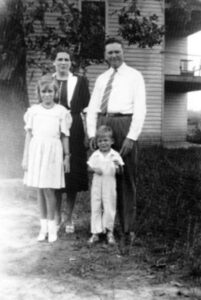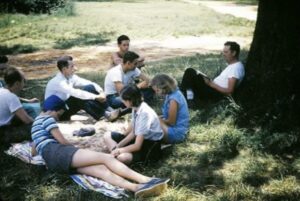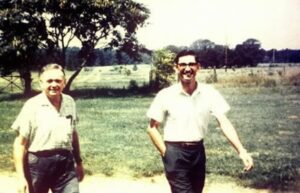 This month, we’re reading The Cotton Patch Evidence: The Story of Clarence Jordan and the Koinonia Farm Experiment (1942-1970) by Dallas Lee.
This month, we’re reading The Cotton Patch Evidence: The Story of Clarence Jordan and the Koinonia Farm Experiment (1942-1970) by Dallas Lee.
Koinonia Farm, a community near Americus, Georgia, was founded by biblical scholar and farmer Jordan, who envisioned a place where people could live and work together regardless of racial differences. He persisted with this vision despite “bullets, bombs, and boycotts.” When local businesses refused to purchase products grown on the farm, Koinonia began a mail-order business that continues today. In the 1970s, Jordan and Millard and Linda Fuller developed the concept of “partnership housing” that eventually grew into Habitat for Humanity.
Join us in learning more about Habitat’s heritage!
Please note that this book was published in 1971, so some language is now outdated, particularly for racial and gender terms. We hope it does not give offense.

1. On page 3, Lee describes the climate of racism in the American South in 1942. What has changed today? What hasn’t?
2. Lee notes that Jordan connected the evils of Nazism in Europe with the racial oppression in the American South. How did his view of Jesus inform this perspective?
3. Jordan noted discrepancies between what people said and sang in church, and the way they treated others outside church. Have you noted any similar discrepancies in what people profess vs. how they live? If so, what has your response been?
4. What were some of the “biblical” arguments Jordan heard from people who wanted to continue enforcing racial segregation? Which passages and verses from the Bible shaped his own thinking? How do you explain those very different interpretations of the Bible?
5. What does koinonia mean? Why did Jordan and his campus study group choose this word to define themselves?
6. What views did Jordan hold regarding war and pacifism? How did his understanding of the Bible inform those views? How did his ideas differ from those of the dominant American culture?
7. What were some of the challenges the Koinonia Farm community faced during their early days? How did they address these challenges?

7. On p. 71, Lee explains the requirement for joining Koinonia Farm: “The new member either had to dispose of his possessions and cash before arrival or turn over such resources to the community.” Why was this a requirement? How would you react to this expectation?
8. On p. 89, Jordan offers his version of the parable of the rich farmer. He concludes, “He lived in bondage to the very things he thought would serve him.” Can you think of anything that’s true for in your life?
9. What interactions did Koinonia have with other communal groups? How were these groups similar? How did they differ?
10. What actions did residents of Americus and Sumter County take to protest Koinonia’s racial integration? How did Jordan and the other Koinonians respond? Why did they choose to stay in Georgia rather than relocating to another, more neutral place?
11. What drew Millard and Linda Fuller to Koinonia Farm?

12. Why did the word “partner” become so important to Jordan and Fuller?
13. What was Jordan’s original vision for the Fund for Humanity? What has it developed into today? (Hint: If you aren’t sure, check out our Fund for Humanity page!)
14. How did Habitat for Humanity develop from the conversations between Jordan and Fuller and from Koinonia Partners? How did involvement in housing change Koinonia Farm?

15. How has Koinonia Farm changed and evolved since 1971, according to the afterword from 2011? What do you think Jordan would think about these changes?
16. What does your faith tradition and/or your personal code of ethics say about equality, racial justice, and community? How do you apply these principles in your own life?
17. Did reading Clarence Jordan’s story challenge you in any way? If so, how?
“We love to bring people from diverse backgrounds together for fellowship and dialogue. Our desire is to provide a setting where people from all races, traditions, and lifestyles can come together to find reconciliation and friendship.”
-From the Afterword by Bren Dubay, p. 249

